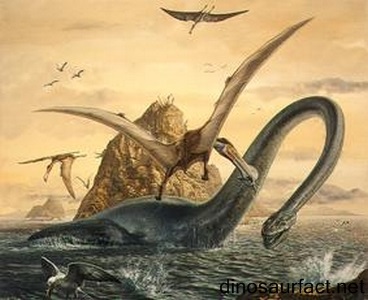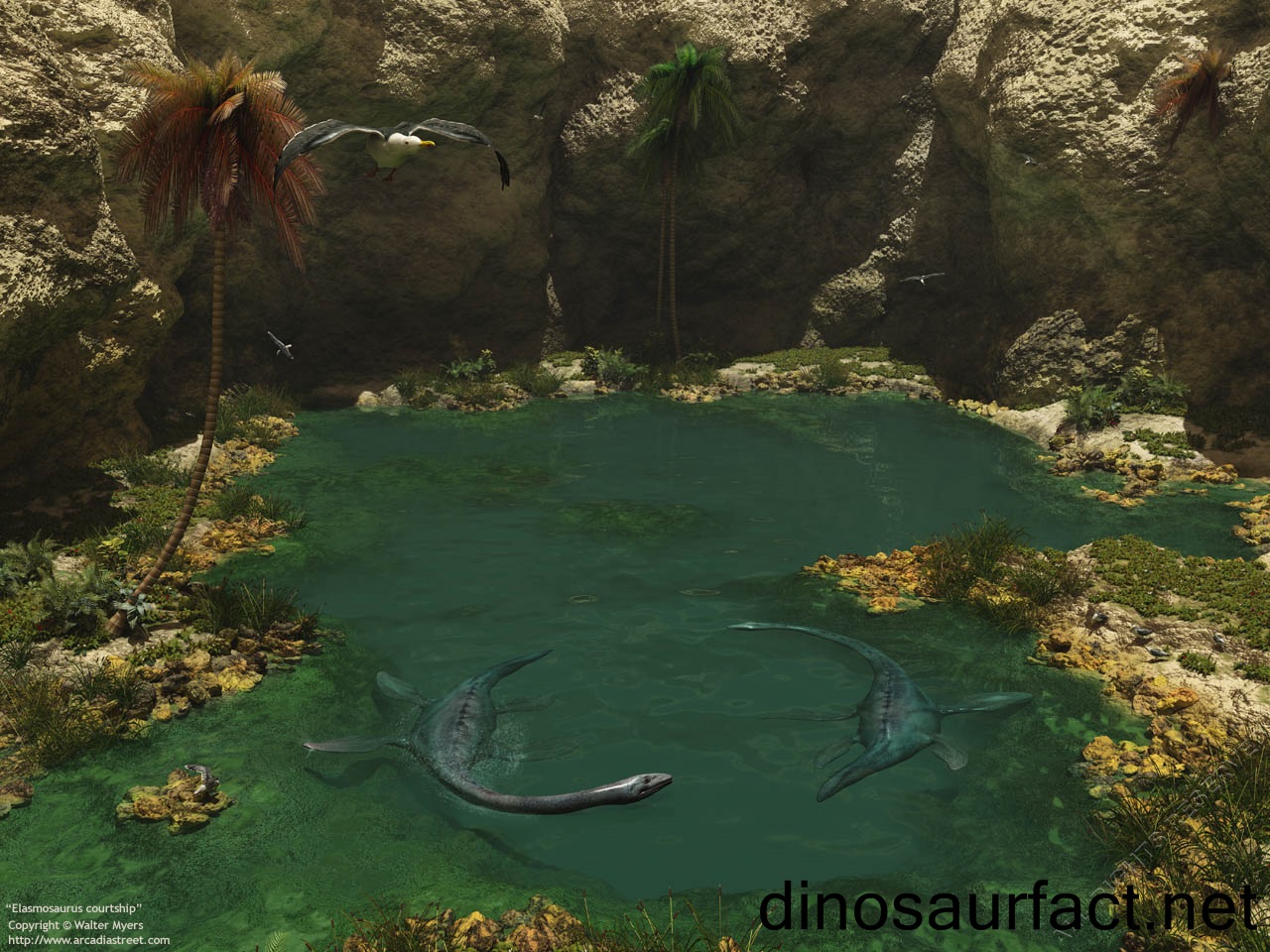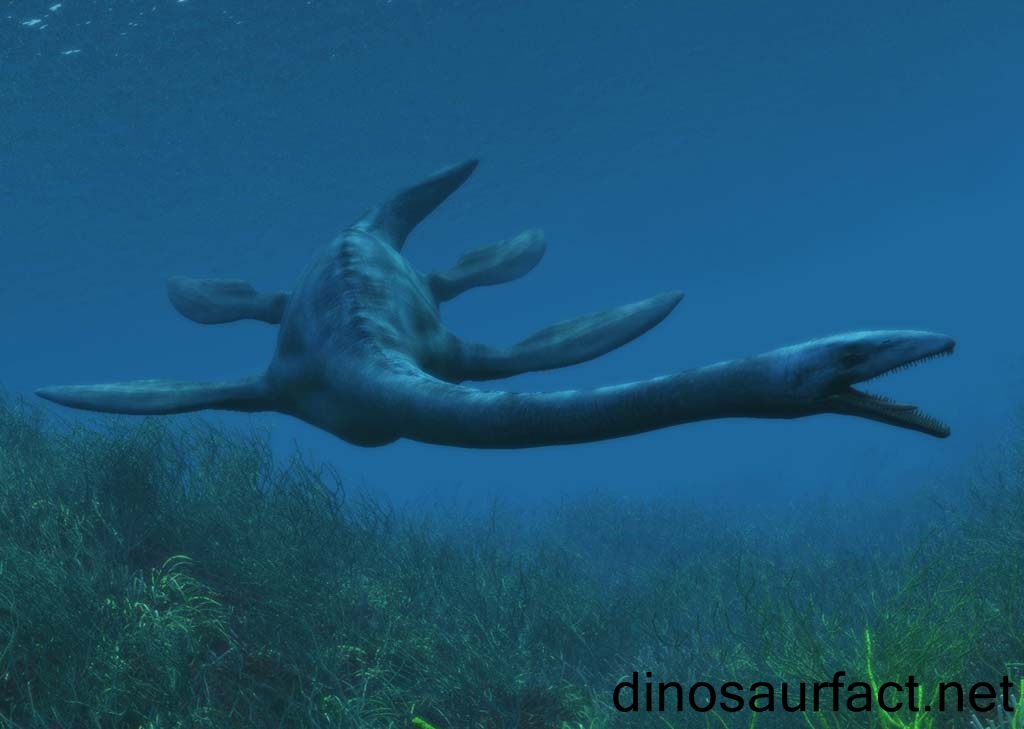 Click to visit the previous Marine Specie bio
Click to visit the previous Marine Specie bio
 |
|
 |
|
Kingdom: Animalia
Phylum: Chordata
Class: Reptilia
SuperOrder: Sauropterygia
Order: Plesiosauria
Family: Elasmosauridae
Genus: Elasmosaurus
 |
|
 |
|
 |
|

The Elasmosaurus, is a specimen of the plesiosaurus family which had a very long neck and roamed the planet during the late Cretaceous period, almost 80.5 million years ago. Just like the Dolichorhynchops, the Elasmosaurus too, inhabited the depths of the ocean and was as skilled as its counterpart.
Appearance
Physically speaking, the Elasmosaurus was almost fourteen meters (forty six feet) long and weighed over two thousand kilograms (2.2 short tons), thus making it amongst the biggest plesiosaurs ever recorded. It differs from all different plesiosaurs in the sense, that it had six teeth at the bones at the tip of the snout and seventy one (cervical) vertebrae.
The head was absolutely flat, with an array of long, sharp teeth forming the dental structure. The neck vertebrae following the cranium were towards the downside, and had a horizontally formed crest. Just like most of the other elasmosaurids, the Elasmosaurus , had three vertebrae on its chest. The tail was made up of at least eighteen vertebrae.
Unlike in the juveniles, the chest girdle amongst the adults featured a protracted bar. The shoulder blade had margins of roughly equal length for the joint and had a coracoid and an articular joint for the higher arm.
The anterior fringe of the pelvic arch was created from three virtually straight edges directed to the front and sides of the animal. This structure, gave a great deal of agility to the animal. The limbs of Elasmosaurus, like those of alternative plesiosaurs, metamorphed into two same sized hard paddles like structures, that helped the creature navigate.
Elasmosaurus- An overview
- A strange creature whose body was dwarfed by its long, skinny neck and tail, Elasmosaurus swam with the help of its four flippers.
- It was a carnivorous hunter that used its long neck to induce unsuspecting preys before they could sense its presence. A swift flick of the neck may have caught them short. It’s tiny head, restricted the amount of what it was able to eat.
- Elasmosaurus spent all its time within the water, usually cruising coastal waters for shoals of fish. It might’ve often dived all the way down to the deepest depths of the shallow areas, to seek out rounded pebbles. Believe it or not, but the Elasmosaurus ate these pebbles in order to digest it’s food.
- Elasmosaurus covered long distances for the purpose of mating and in search of breeding grounds. There’s also proof of them being very protective for their young ones, as it is assumed, that they looked after them till the time they were able enough to do so themselves.
- Elasmosaurus is Greek for "ribbon lizard" and is pronounced as “el-LAZZ-moe-SORE-us”.
- The Elasmosaurus was distinguished by its exceptionally long neck. This forty to fifty foot-long Archosaur had more vertebrae as compared to the other specimens of its species.
- This uncommon feature has led to some disagreement regarding the way Elasmosaurus searched for fish: some paleontologists assume that it bent its head sideways around its body, whereas others believe that it swam close to the surface like a crocodile, eyeing its prey patiently.
- Elasmosaurus, in all probability, wasn't a quick swimmer. Not that it required speed if it used to employ the stalking technique to approach its prey from down below.
- While the Elasmosaurus was fantastically made for exclusive aquatic life,
- Their paddle-shaped limbs were stiff . So they might at best have served the only purpose of pushing its body onwards.
- While no concrete proof presently exists for Elasmosaurus either laying eggs or giving birth to its young ones,
- Since its naming back in
The discovery
The Elasmosaurus specimen was discovered in March, 1868 by Edward Drinker Cope in western Kansas, USA. Though different specimens of Elasmosaurus are found in numerous locations in North America, it was determined that the Elasmosaurus platyrus was the ultimate representative of its genus.
An interesting anecdote survives, detailing as to how Cope had tried to assemble the Elasmosaurus remains. Finding the numerous neck bones, Cope thought that the bones belonged to the tail. Being under the impression that most reptiles had a long tail but a short neck, he arranged the bones towards its rear end, thus forming a tail with its neck bones.
However, popular rumor has it, that eminent paleontologist, Othniel Charles Marsh, upon realizing that the head had been positioned on the incorrect side, ridiculed Cope for putting it there.
Some say, that it was actually Joseph Leidy who pointed this error out, in a full public gathering.
It is believed, that it was this criticism that had irked Cope and had further fuelled the already burning rivalry that saw a fierce sense of competition between Cope and Marsh. Both of them, started making attempts to outdo each other in terms of discovering new Jurassic species.
The Elasmosaurus remains an enigma. With the entire knowledge derived from just 3 specimens, the confusion surrounding the creature is understood. However, that only makes it all the more alluring.
Index
Extinct Profiles
 Triassic Dinosaurs
Triassic Dinosaurs Jurassic Dinosaurs
Jurassic Dinosaurs Cretaceous Dinosaurs
Cretaceous Dinosaurs Pterosaurs
Pterosaurs Marine Reptiles
Marine Reptiles Dinosaur Extinction
Dinosaur Extinction